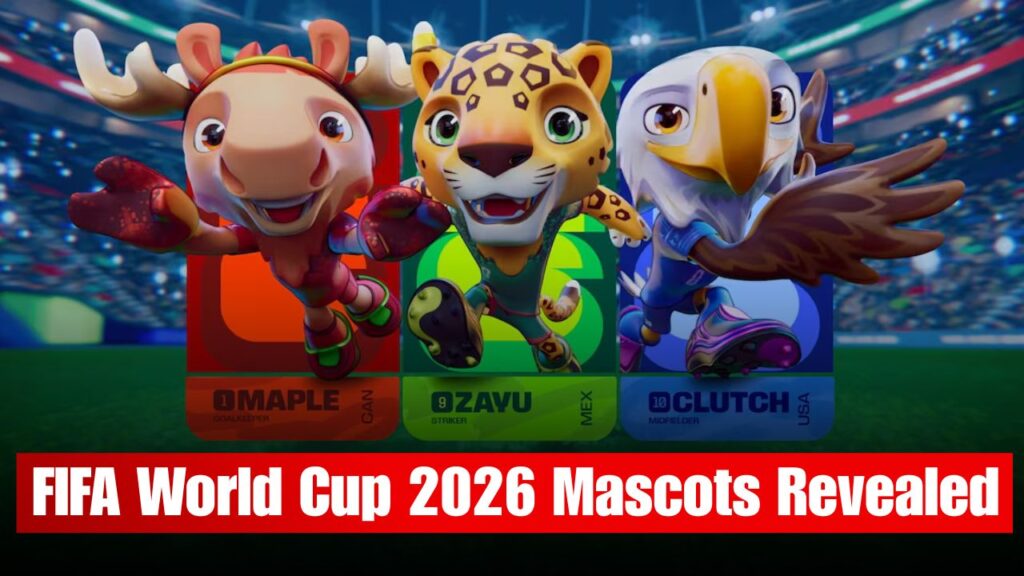FIFA World Cup 2026 Mascots: The excitement for the upcoming World Cup 2026 just got even bigger as FIFA officially revealed its trio of mascots — Maple, Zayu, and Clutch. These charming characters symbolize unity, culture, and the diverse spirit of the host nations — the United States, Canada, and Mexico. Each mascot carries its own backstory, connecting football fans around the world to the unique heritage and energy that will define the 2026 tournament. Let’s dive deeper into what these mascots truly represent and how their names were chosen.

Meet the New Faces of the FIFA World Cup 2026
The trio of Maple, Zayu, and Clutch will headline global campaigns and fan events leading up to the tournament. Maple represents Canada’s warm-hearted community and its love for inclusion, symbolized through the iconic maple leaf. Zayu embodies Mexico’s colorful culture, energy, and endless passion for football, while Clutch brings in the creative and determined spirit of the United States. Together, these characters reflect how the World Cup 2026 is more than just a competition — it’s a celebration of three nations united through the world’s favorite sport.
The Meaning Behind Maple, Zayu, and Clutch
Each mascot’s name carries a unique cultural and emotional meaning. Maple was inspired by Canada’s national symbol, showcasing pride and unity. Zayu takes influence from traditional Mexican folklore, blending history with youthful energy. Meanwhile, Clutch represents the American drive to perform under pressure — a term often used in sports for someone who shines in critical moments. These FIFA mascots were designed to resonate with fans of all ages, reminding everyone that football’s beauty lies in its ability to bridge cultures and inspire global harmony.
Symbolism and Global Impact of FIFA 2026 Mascots
The introduction of FIFA 2026 mascots marks a new era of fan engagement. These characters are not just for entertainment — they symbolize the unity of nations, environmental awareness, and the shared goal of promoting youth participation in football. FIFA plans to feature them in digital campaigns, school programs, and community outreach efforts across North America. By giving each mascot a clear identity and message, FIFA aims to create an emotional bond that will make the World Cup 2026 memorable long before the first match kicks off.
Design Details and Fan Reactions
The designs of Maple, Zayu, and Clutch were revealed through a global live stream, instantly sparking excitement across social media. Fans praised their fresh look and cultural depth. Each mascot features vibrant color themes inspired by their respective countries’ flags. Designers focused on creating relatable, fun characters that children and adults can both enjoy. FIFA’s marketing team expects these mascots to become the most recognizable in tournament history, generating a wave of global enthusiasm for the FIFA World Cup 2026.
| Character | Country | Symbolism | Key Traits |
|---|---|---|---|
| Maple | Canada | Friendship, Unity, Kindness | Warm-hearted, Inclusive, Cheerful |
| Zayu | Mexico | Passion, Culture, Energy | Colorful, Energetic, Spirited |
| Clutch | United States | Determination, Performance, Leadership | Confident, Motivated, Strong-willed |
FAQ 1: When were the FIFA 2026 mascots revealed?
The official mascots were revealed by FIFA in October 2025 through a global virtual event.
FAQ 2: What do Maple, Zayu, and Clutch symbolize?
They represent the unity, diversity, and passion of the three host nations — Canada, Mexico, and the USA.
FAQ 3: Will the mascots appear in FIFA merchandise?
Yes, fans can expect toys, apparel, and collectibles featuring Maple, Zayu, and Clutch ahead of the tournament.
FAQ 4: Why did FIFA choose three mascots instead of one?
Because the 2026 World Cup will be jointly hosted, FIFA wanted each nation to have its own symbolic character.



